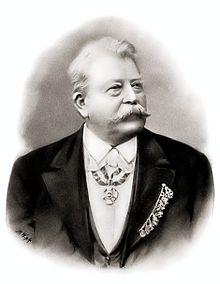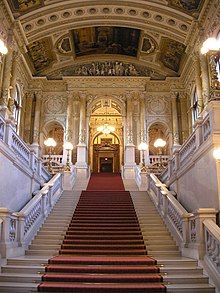Anton Detoma
Anton Detoma (* around 1820 in Rima San Giuseppe ; † October 25, 1895 in Varallo (Piedmont) ) was an important art marble artist and plasterer at the end of the 19th century. He worked mainly in Bavaria , Berlin and finally in Vienna . He was the founder of an art-industrial establishment and was appointed kuk court art marbler and plasterer for his services .
biography
Coming from Italy, Commendatore Anton Detoma spent his apprenticeship years in Munich in the era of the revival of the arts and sciences and under the art-loving King Ludwig I. The Viotti brothers, who excelled in stucco work, successfully instructed the young Detoma in this area, and soon he surpassed most of his colleagues in skill and taste. At that time, King Oskar I of Sweden summoned excellent masters and skilled disciples to his court to carry out several buildings. Detoma was also invited to Stockholm in 1844 . This year is therefore to be regarded as the beginning of Anton Detoma's independent effectiveness and is also the year the company was founded. The work in the Royal Stockholm Palace kept him busy for a long time, and only after ten years did he leave Sweden to accept a call to Schwerin .
After completing the Schwerin work, he was honored by his appointment to Berlin from the director of work on the Kronprinzenpalais , Privy Councilor Strack. With renewed zeal he devoted himself to these tasks and solved them just as completely as the earlier ones in Schwerin. This was followed by work in the Royal Museum, the Army Museum, the Stock Exchange, the Royal Residence and the Reich Chancellor's Palace in Berlin. Detoma soon became known in Vienna and he was called to Trieste to build the Palais Rivoltella .
Now came a major turning point in his life. The builder of the Votive Church , Heinrich von Ferstel , entrusted him with several excellent works, such as the one in artificial marble in the former stock exchange hall, which later became the military casino, in the Palais Ferstel . In April 1856, Detoma decided to settle permanently in Vienna.
Detoma became one of the leading art marbles and plasterers in Austria-Hungary. Significant works during his 36-year career in Vienna were the Reichsratsgebäude , the new Vienna City Hall , the main building of the University of Vienna , where the numerous marble and plaster stucco works were assigned to Detoma. The Palace of Justice under the architect Wielemann offered him a task . Here he was assigned the decoration of the most outstanding rooms, for example the central hall, offices, foyer. The meeting room of the Lower Austrian Trade Association was also decorated by him.
Another highlight of Detoma's achievements is the relevant work in the Vienna court theaters, the two court museums, the Vienna Stock Exchange , the Academy of Fine Arts , and the Austrian Museum of Art and Industry . Detoma also received many commissions from the imperial court. He was employed in the Vienna Hofburg and in the Lainzer Schloss. Archduke Karl entrusted him with the decoration of the ballroom of his palace, Archduke Ludwig Viktor entrusted him with the decoration of all the state rooms in his palace on Schwarzenbergplatz and in Schloss Kleßheim in Salzburg. Archduke Wilhelm used Detona's services for his palace on Parkring . Detoma also worked on behalf of Duke Adolf von Nassau in the new ducal palace on Reisnerstrasse. Prince Johann von und zu Liechtenstein also used him very often for new buildings and restorations . Detoma's works in other countries and the provinces of Austria include the cathedral church in Raab, the Royal Hungarian National Museum in Budapest , the auditorium in the central seminar there, the city theater in Brno , the archbishop's residence and basilica in Gran, the administration building of the Austro-Hungarian Lloyd in Trieste, the Pálffy Palace in Bagmosz, the House of the Building Industry at 20 Schaumburgergasse in Vienna, etc.
Detoma also performed in the Bavarian royal castles. When King Ludwig II began building his Herrenchiemsee Palace in 1878 , he first wanted to have the interior decoration done in natural marble. However, when Archduke Ludwig Viktor drew his attention to Detoma and its achievements, he appointed the master, who also managed to achieve a much greater effect with his artificial stone work than the use of natural marble would have allowed. There are also works by Detoma in Hohenschwangau Castle .
But Detoma was not just an artist, its importance extends further than the one who trained the stucco, marble and stuccolucido technique and brought it to its then high level. He also acted as a teacher and stimulator. Numerous students owed him the introduction to these techniques. Some of them have been in the service of his company for 30-40 years, others have transplanted their master's teachings to many European countries, such as Germany, Sweden and Romania.
Detoma's achievements have also received recognition in many cases. For his outstanding participation in almost all monumental buildings in Vienna, Budapest and Berlin, he was honored with high awards and appointed as supplier to the imperial court. Foreign sovereigns and many corporations had honored him with medals and decorations.
Detoma died in 1895. His son Anton Detoma jun. continued the A. Detoma established by his father in the spirit of the old tradition. He looks after all branches of the company, the work in stucco and cement marble, stuccolucido, artificial stone, etc., and was also very successful. His work included further work in the New Castle in Vienna and Budapest, the basilica and the royal curia in Budapest, Heinrich Mattoni's source temple in Gießhübl , the synagogue in Prague and many other objects.
literature
- Anton Detoma, in: Die Groß-Industrie Oesterreichs. Commemoration for the glorious fiftieth anniversary of the reign of His Majesty the Emperor Franz Josef I, offered by the industrialists of Austria in 1898. Volume 6. Weiss, Vienna 1898, pp. 88–89.
- Otto Schwarz. Behind the facades of the Ringstrasse: history - people - secrets. Amalthea, Vienna 2007, ISBN 3-85002-589-6 , p. 29.
Individual evidence
- ↑ A. Detoma. In: Anniversary number of the imperial Wiener Zeitung 1703–1903. Supplement commercial part. Alfred von Lindheim. Druck und Verlag KK Hof- und Staatsdruckerei, Vienna, August 8, 1903, p. 76 , accessed on August 24, 2009 .
| personal data | |
|---|---|
| SURNAME | Detoma, Anton |
| BRIEF DESCRIPTION | important art marbler and plasterer |
| DATE OF BIRTH | around 1820 |
| PLACE OF BIRTH | Rima San Giuseppe |
| DATE OF DEATH | October 25, 1895 |
| Place of death | Varallo (Piedmont) |


